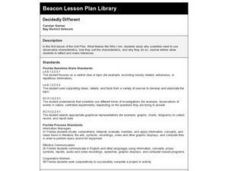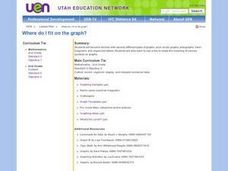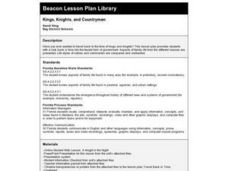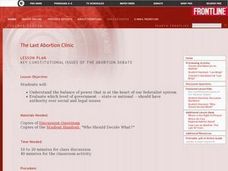Curated OER
"Julie of the Wolves"
Fifth graders research life in Alaska and compare life there to their lives in this lesson. They read "Julie of the Wolves." They research through the novel and other reference books facts about the Alaskan climate and geography. They...
Curated OER
Troublesome Towers
Learners observe solids and identify parts that make up the surface area. In this geometry instructional activity, students calculate the surface are of solids and cones. They find polygons and solids in the real world.
Curated OER
How Did We Arrive at the Printed Book?
Seventh graders, in cooperative learning groups, research the development of book printing. After examining a story written on a scroll, an accordion book, and a printed copy, they evaluate them according to a certain criteria and...
Curated OER
A Tour of Saturn and Uranus
Second graders draw and label each planet, Saturn and Uranus, showing 2 specific individual characteristics of each.
Curated OER
Bone's Adventures
Students read and discuss a chapter from the book "A Dog's Life," focusing on the point of view of the dog in the story. They explore dog rescue organization websites, and play the online game "Bone Travels On," creating a story map and...
Curated OER
It's in the Elements - Lesson Four
Students compare and contrast story elements in two versions of Cinderella. In this literature elements lesson plan, students are read two different versions of Cinderella, they identify the characters, plot, and setting, then they...
Curated OER
Excel temperature Graphs
Students gather data about the weather in Nome, Alaska. In this Nome Temperature lesson, students create an excel graph to explore the weather trends in Nome. Students will find the average weather and add a trend line to their graph.
Alabama Learning Exchange
Exploring Plant Leaves
First graders investigate plants and leaves by taking nature walks and researching the Internet. They examine the similarities and differences in the plants and leaves. They create their own leaves at an interactive Internet site and...
Curated OER
Angle Exploration and Classification
Students compare and contrast angles and identify them as acute, obtuse, right, or straight angles. They create rays and angles using uncooked spaghetti, read and discuss key vocabulary terms, and complete a variety of geometry worksheets.
Curated OER
Straberry Girl: Florida's Location and Shape
Students explore geography by reading a story about Florida. In this Florida vegetation lesson, students read the book Strawberry Girl and identify the locations in Florida that are mentioned in the book. Students identify the type of...
Curated OER
Rainforest Relationships
Students provided with opportunities to explore the animals and plant life that coexist in the various layers of the tropical rainforest. They appreciate the diversity of life in each layer. Students write a report on a particular plant,...
Curated OER
Decidedly Different
Fifth graders inquire as to why scientists use observable characteristics, how they sort the characteristics, and why they do so. They write journal entries to be used throughout this unit.
Curated OER
Comparing Composers: Beethoven and Mozart
Students read brief biographies of Mozart and Beethoven and identify the composer identified in each of 15 statements on the student work sheet.
Curated OER
Deception and Advertising: When is it Misleading and when is it Puffery?
Eighth graders explore advertisements and deception in advertising. In this marketing and advertising lesson, 8th graders write cause and effect paragraphs describing products, promises made, deceptions caused, and the immediate...
Curated OER
Where Do I Fit on the Graph?
Young scholars collect data and create graphs about themselves, their community, and the world around them. They use a variety of methods to organize data, such as stickers, clothespins, name tags, coloring, tally marks, etc.
Curated OER
Experiencing Japanese Feudalism
Students identify that a system of feudalism similar to that of medieval Europe developed in Japan by 1300. Students identify the social hierarchy of feudal Japan. Students identify what the cultural basis for the relationships among...
Curated OER
Weather Observation Journal
Students record weather for a period of one month. In this weather lesson, students observe weather for one month on a large pictograph. Students record clouds, wind, temperature and any other weather conditions they observe. Students...
Curated OER
Dealing with Differences
Students list at least ten things they have a hard time doing. After reading and discussing Be Good to Eddie Lee, Students, in cooperative groups, write at least six ways people can assist people with disabilities.
Curated OER
Kings, Knights, And Countrymen
Middle schoolers look back in time into the feudal form of government. They view Powerpoint presentations to take them back in time.
Curated OER
To Be or Not to Be - Abiotic/Biotic Factors
Students define and compare/contrast abiotic and biotic factors presented while using web cameras on the Web World Wonders website.
Curated OER
The Last Abortion Clinic: Key Constitutional Issues of the Abortion Debate
Students discuss the Constitution of the United States and its amendments, then apply this discussion by creating a "Who should Decide What?" list, based upon their ideas about whether controversial issues such as abortion and medical...
Curated OER
Polluting the Environment
Fourth graders construct mini-ecosystem, pollute the ecosystem, observe, collect, and record data on the effects of these pollutants on their ecosystem, organize data on spreadsheets, create graphs, and design presentations to share with...
Curated OER
The Mighty Hudson Stretches its Mussels
Students brainstorm possible causes of zebra mussel migration and population expansion. They identify the key causes and effects of the disturbance of the Hudson River ecosystem and research causes and effects in the disturbances of...
Curated OER
Roll or Slide?
Students explore models of three-dimensional shapes. In this geometric shapes instructional activity, students use hands-on manipulatives to explore three-dimensional shapes. Students predict whether each shape will roll or slide.























